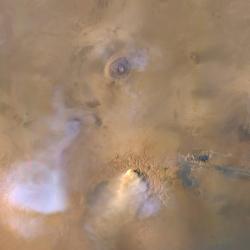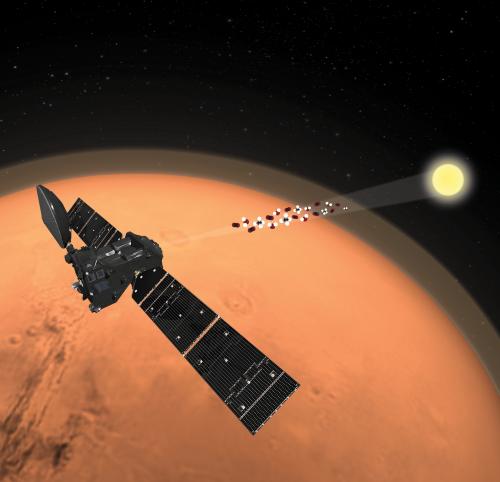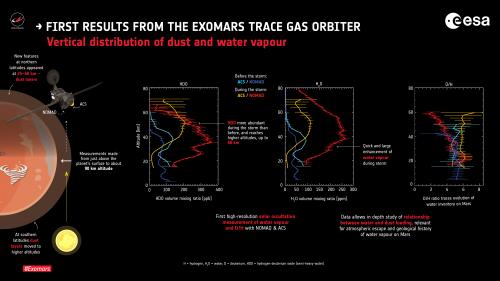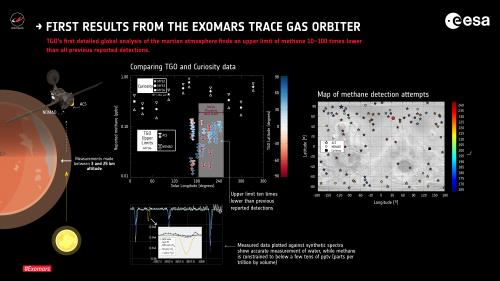Today, the prestigious journal Nature publishes two papers describing the first results of the Belgian NOMAD instrument on board ExoMars Trace Gas Orbiter. New evidence of the impact of the recent planet-encompassing dust storm on water in the atmosphere, including the first vertical measurements of semiheavy water on Mars, and a surprising lack of methane, are among the scientific highlights of the ExoMars Trace Gas Orbiter’s first year in orbit. Principal Investigator of the NOMAD instrument, Ann Carine Vandaele at the Royal Belgian Institute for Space Aeronomy is delighted with these results.
The joint ESA-Roscosmos ExoMars Trace Gas Orbiter, or TGO, arrived at the Red Planet in October 2016, and spent more than one year using the aerobraking technique needed to reach its ultimate two-hour science orbit at 400 km above the surface of Mars. The science objective of TGO and its Belgian contribution NOMAD is to survey the atmospheric composition of Mars down to an unprecedented accuracy.
Its main science mission began at the end of April 2018, and by coincidence, only a couple of months later, in June, the largest dust storm ever observed on Mars occurred. NOMAD on TGO was able to make unique observations following the onset and development of the storm and monitoring how the increase in dust affected the water vapour in the atmosphere.
Most importantly, for the first time the vertical distribution of semiheavy water (HDO)1 was measured on Mars – important for understanding the history of water on Mars over time. Mars has been suspected to have been rich in water, including liquid water, in the past, and one of the most fascinating mysteries is what happened to this water. The NOMAD observations will contribute to the answer of that long-standing question.
In addition, NOMAD also searched for methane, an organic compound that may contain the key to the question if Mars ever harbored Life. While methane was repeatedly reported by several space missions and observations from Earth in the past – including last week’s discovery of a methane spike in 2013 by a different ESA mission, to which the Royal Belgian Institute for Space Aeronomy also contributed.
However, NOMAD and its accompanying instrument on TGO, the Russian spectrometer ACS, did not detect any methane down to very low abundances. This is not reconcilable with the previous detections by any of the known physical and chemistry processes, which means it adds more mystery to the story of methane on Mars.
Exploiting the dust storm
The two spectrometers onboard TGO – NOMAD and ACS – made the first high-resolution solar occultation measurements of the atmosphere. By looking at the way sunlight is absorbed in the atmosphere, NOMAD is able to measure the vertical distribution of water vapour (H2O) and ‘semi-heavy’ water (HDO) from close to the martian surface to above 80 km altitude. The new results track the influence of dust in the atmosphere on water, along with the escape of hydrogen atoms into space.
Ann Carine Vandaele, Principle Investigator of NOMAD says:
In the northern latitudes we saw dust clouds arise at altitudes of around 25-40 km that were not there before, and in southern latitudes we saw dust layers moving to higher altitudes. The enhancement of water vapour in the atmosphere, in reaction to the solar heat absorption by this dust, happened remarkably quickly, over just a few days during the onset of the storm, indicating a swift reaction of the atmosphere to the dust storm. The observations are consistent with our global circulation models.
The teams also made the first observations of the vertical distribution of semiheavy water simultaneously with water vapour, providing key information on the processes that control the amount of hydrogen and deuterium atoms escaping to space.
Ann Carine continues:
For the first time, the vertical distribution of the deuterium-to-hydrogen (D/H) ratio could be derived, which is an important marker for the evolution of the water inventory on Mars. With this information, computer models can be more confined and this will improve our understanding of the fate of the – ever so water-rich – atmosphere of Mars.
Methane mystery thickens
NOMAD also started its measurements of other trace gases in the martian atmosphere. Trace gases occupy less than one percent of the atmosphere by volume, and require highly precise measurement techniques to determine their exact chemical fingerprints in the composition.
Methane is of particular interest for Mars scientists, because on Earth, it can be a signature of:
- life
- geological processes
Because it can be destroyed by solar radiation only on timescales of several hundred years, any detection of the molecule in present times implies it must have been released relatively recently – even if the methane itself was produced millions or billions of years ago and remained trapped in underground reservoirs until now.
In addition, trace gases are mixed efficiently on a daily basis close to the planet’s surface, with global wind circulation models dictating that methane would be mixed evenly around the planet within a few months.
Reports of methane in the martian atmosphere have been intensely debated because detections have been very sporadic in time and location, and often fell at the limit of the instruments’ detection limits.
Instrument scientist Frank Daerden explains:
The new results from TGO provide the most detailed global analysis yet, and NOMAD measurements were fully supported by the ACS instrument. No methane was detected down to an upper limit of 0.05 ppbv (parts per billion by volume, meaning less than 50 methane molecules per trillion (1012) air molecules) during its first year of observations. This still means up to 500 tons of methane could be emitted over a 300 year predicted lifetime of the molecule when considering atmospheric destruction processes alone, but dispersed over the entire atmosphere, this is extremely low, 10-100 times lower than all previous reported detections.
It means that we do not understand the previous measurements, and if they are correct, it implies that methane must be destroyed on Mars in a very peculiar process, not yet understood.
NOMAD on Exomars TGO was designed, managed and developed in Belgium, under the scientific lead of the Royal Belgian Institute for Space Aeronomy, with support from the Belgian Science Policy Office (BELSPO), with partners in Spain, Italy and the UK, and with additional scientific support from the USA, Canada and Japan. The instrument is performing as expected and has been designed to continue observing the Martian atmosphere for several years to come.
Semi-heavy water
1 Water consists of two hydrogen atoms and one oxygen atom: H2O. HDO is a form of water in which one of the two hydrogen atoms has been replaced by a heavier variant: the deuterium atom D.
More information:
- ESA ExoMars webstory
- “No detection of methane on Mars from early ExoMars Trace Gas Orbiter observations” by O. Korablev et al, published in the journal Nature.
- “Martian dust storm impact on atmospheric H2O and D/H observed by ExoMars Trace Gas Orbiter” by A.C Vandaele et al, published in the journal Nature.
- Livestream of the press conference at EGU, Vienna, where the first results were presented.




